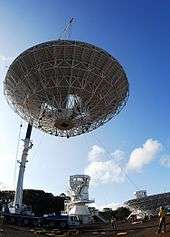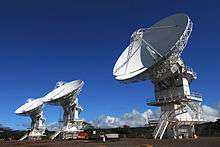Mobile User Objective System

The Mobile User Objective System is a narrowband military communications satellite system that supports a worldwide, multi-Service population of users in the ultra high frequency band. The system provides increased communications capabilities to newer, smaller terminals while still supporting interoperability with legacy terminals. MUOS is designed to support users that require greater mobility, higher bit rates and improved operational availability.
Overview

The Mobile User Objective System (MUOS) is an Ultra High Frequency (UHF) (300 MHz to 3 GHz frequency range) SATCOM system, primarily serving the United States Department of Defense (DoD). International allies use is under consideration.[1] The MUOS will replace the legacy UHF Follow-On (UFO) system before that system reaches its end of life to provide users with new capabilities and enhanced mobility, access, capacity, and quality of service. Intended primarily for mobile users (e.g. aerial and maritime platforms, ground vehicles, and dismounted soldiers), MUOS will extend users' voice, data, and video communications beyond their lines-of-sight.[2]
MUOS is an array of geosynchronous[3] satellites that will provide global satellite communications (SATCOM) narrowband connectivity for communications use by the United States at data rates up to 384kbit/s. The program will deliver five satellites, four ground stations, and a terrestrial transport network at a cost of $7.34 billion USD.[4]
The Navy's Communications Satellite Program Office (PMW 146)[5] of the Program Executive Office (PEO) for Space Systems in San Diego is lead developer for the MUOS Program. Lockheed Martin is the Prime System Contractor and satellite designer for MUOS under U.S Navy Contract N00039-04-C-2009,[6][7] which was announced September 24, 2004. Key subcontractors include General Dynamics Mission Systems (Ground Transport architecture), Boeing (Legacy UFO and portions of the WCDMA payload) and Harris (deployable mesh reflectors). Full on-orbit capability is expected by 2015.
WCDMA system
The MUOS operates as a global cellular service provider to support the war fighter with modern cell phone-like capabilities, such as multimedia. It converts a commercial third generation (3G) Wideband Code Division Multiple Access (WCDMA) cellular phone system to a military UHF SATCOM radio system using geosynchronous satellites in place of cell towers. By operating in the UHF frequency band, a lower frequency band than that used by conventional terrestrial cellular networks, the MUOS provides warfighters with the tactical ability to communicate in "disadvantaged" environments, such as heavily forested regions where higher frequency signals would be unacceptably attenuated by the forest canopy. The MUOS constellation will consist of four operational satellites and one on-orbit spare. MUOS will provide military point-to-point and netted communication users with precedence-based and pre-emptive access to voice, data, video, or a mixture of voice and data services that span the globe. Connections may be set up on demand by users in the field, within seconds, and then released just as easily, freeing resources for other users. In alignment with more traditional military communications methods, pre-planned networks can also be established either permanently or per specific schedule using the MUOS' ground-based Network Management Center.
Legacy payload
In addition to the cellular MUOS WCDMA payload, a fully capable and separate UFO legacy payload is incorporated into each satellite. The "Legacy" payload extends the useful life of legacy UHF SATCOM terminals and enables a smoother transition to MUOS.
Launches
After several range weather delays, the first MUOS satellite, MUOS-1, launched into space successfully on February 24, 2012, carried by an Atlas V rocket flying in its 551 configuration.[8]
MUOS-2 launched on schedule on July 19, 2013, at 13:00 UTC aboard an Atlas V 551 (AV-040).[9]
MUOS-3 was encapsulated into its payload fairing on December 19, 2014, paving the way for its launch on board the United Launch Alliance (ULA) Atlas V rocket on January 20, 2015, from Cape Canaveral Air Force Station, Florida.[10]
MUOS-4 arrived at Cape Canaveral July 31, 2015.[11] Weather conditions pushed back the launch, which was originally scheduled for August 31, 2015, at 10:07 UTC.[12][13] The launch took place September 2, 2015, at 10:18 UTC.[14]
MUOS-5 arrived at Cape Canaveral on March 9, 2016.[15] Launch was originally scheduled for May 5, 2016, but due to an internal investigation into an Atlas V fuel system problem during the Cygnus OA-6 launch on March 22, the scheduled date was pushed back.[16] The launch took place on June 24, 2016, at 14:30 UTC.[17] An "anomaly" aboard the satellite occurred a few days later, however, when it was still in a Geostationary Transfer Orbit (GTO), leaving it "Reconfigured into Safe Intermediate Orbit", or stranded in GTO.[18][19] Amateur observers tracked it in an orbit of approximately 15,240 × 35,700 km (9,470 × 22,180 mi) since July 3, 2016.[20] On November 3, 2016 the Navy announced that the satellite has finally reached operational orbit.
MUOS operational positions
The four currently operational MUOS satellites are stationed at longitude 177° W (MUOS 1); 100° W (MUOS 2); 15.5° W (MUOS 3); and 75° E (MUOS 4).[21] MUOS 5 was intended for longitude 72° E. They have a 5° orbital inclination. In the first few months after launch, the satellites were temporarily parked in a check-out position at longitude 172° W.[22]
MUOS ground stations

The MUOS will include four ground station facilities.[2] Site selections were completed in 2007 with the signing of a Memorandum of Agreement (MOA) between the U.S. Navy and the Australian Department of Defence. The four ground stations, each of which serves one of the four active satellites of the MUOS constellation will be located at: the Australian Defence Satellite Communications Station at Kojarena about 30 km east of Geraldton, Western Australia; Naval Radio Transmitter Facility (NRTF) Niscemi about 60 km from Naval Air Station Sigonella, Sicily, Italy; Naval SATCOM Facility, Northwest Chesapeake, Southeast Virginia at 36.564393,-76.270477; and the Naval Computer and Telecommunications Area Master Station Pacific, Hawaii.
Controversy
Construction of the ground station in Italy was halted for nearly half of 2013 caused by protesters concerned with health risks and environmental damage due to radio waves. One scientific study 'point[s] to serious risks to people and the environment, such as to prevent its realization in densely populated areas, like the one adjacent to the town of Niscemi.' [23] The system is not considered fully operational until all four ground stations are completed and turned over to the Navy. The other ground stations were turned over in 2012 and 2013.
In spite of the controversy, the site at Niscemi was completed in anticipation of the launch of MUOS-4.
Radio terminals
The MUOS Waveform with complete red/black operational capability was released in 2012. Until the Joint Tactical Radio System (JTRS) program cancellation in 2011, the JTRS program would provide the DoD terminals that can communicate with the MUOS WCDMA waveform with a series of form-factor models. The JTRS Handheld, Manpack & Small Form Fit (HMS) AN/PRC-155 manpack built by General Dynamics Mission Systems survived the wider JTRS program cancellation and has shipped several low rate of initial production (LRIP) units. Several non-program of record terminals have also been developing MUOS waveform capatibility such as the Rockwell Collins AN/ARC-210[24][25] airborne terminal and Harris Corporation AN/PRC-117G[26][27] Manpack.
Arctic and Antarctic capabilities
In 2013, the prime contractor Lockheed Martin and an industry team of radio vendors demonstrated extensive Arctic communications reach near the north pole, believed to be the most northerly successful call to a geosynchronous satellite.[28] WCDMA calls to the far north will be increasingly important where there has been an increase in shipping, resource exploration and tourism without much improvement in secure satellite communications access. Based on the tests, full coverage of the northwest passage and northeast passage shipping lanes is expected. Several follow-on tests with high quality voice and data including streaming video have occurred in both the Arctic and Antarctic, including a 2015 demonstration from McMurdo Station.[29]
See also
References
- ↑ "U.S. Allies' Access to MUOS Debated after North Pole Satcom Demo". spacenews.com. SpaceNews. Retrieved November 8, 2013.
- 1 2 Military Communications Satellite System Multiplies UHF Channel Capacity for Mobile Users, a Mobile User Objective System (MUOS) design study.
- ↑ Geosynchronous Satellites for MUOS Samuel J. MacMullan, Christopher J. Karpinsky, Reuben E. Eaves, Andre R. Dion; M.I.T. Lincoln Laboratory, 1999.
- ↑ "GAO-13-294SP DEFENSE ACQUISITIONS Assessments of Selected Weapon Programs" (PDF). US Government Accountability Office. March 2013. pp. 99–100. Retrieved May 26, 2013.
- ↑ Fact Sheet, Navy Communications Satellite Programs.
- ↑ SPAWAR N0003904C2009 Contract Award Announcement.
- ↑ DoD Contract Awards for September 24, 2004.
- ↑ Graham, William; Bergin, Chris (February 24, 2012). "Atlas V finally launches with MUOS – Centaur celebrates milestone". NASA Spaceflight.
- ↑ Graham, William (July 19, 2013). "ULA Atlas V launches with MUOS-2 satellite". NASA Spaceflight.
- ↑ "US Navy prepares for third MUOS satellite launch". Naval-technology.com. January 5, 2015.
- ↑ Charlton, Jonathan (July 1, 2015). "U.S. Navy's MUOS-4 Shipped for August Launch". Space News.
- ↑ Ray, Justin (August 28, 2015). "Tropical weather threatens Monday's scheduled Atlas 5 launch". Spaceflight Now.
- ↑ "Counting Down: U.S. Navy, Lockheed Martin Ready to Launch MUOS-4 Secure Communications Satellite August 31" (Press release). Lockheed Martin. August 28, 2015.
- ↑ Ray, Justin (September 1–2, 2015). "Live coverage: Atlas 5 countdown and launch journal". Spaceflight Now.
- ↑ Ray, Justin (March 9, 2016). "MUOS 5 satellite comes to Florida on way to geosynchronous orbit". Spaceflight Now.
- ↑ Ray, Justin (April 12, 2016). "New target date for next Atlas 5 launch". Spaceflight Now.
- ↑ Gruss, Mike (June 24, 2016). "Atlas 5 returns to flight with launch of Navy's MUOS-5". Space News. Retrieved August 14, 2016.
- ↑ "MUOS-5 Transfer Maneuver Temporarily Halted, Satellite Reconfigured into Safe Intermediate Orbit". United States Navy. July 8, 2016. Retrieved July 11, 2016.
- ↑ Ray, Justin (July 8, 2016). "Navy's new MUOS 5 communications satellite experiences snag in space". Spaceflight Now. Retrieved August 14, 2016.
- ↑ Langbroek, Marco (July 8, 2016). "MUOS 5 stuck in GTO". SatTrackCam Leiden (b)log. Retrieved July 11, 2016.
- ↑ "J.D. Oetting and Tao Jen: The Mobile User Objective System. Johns Hopkins APL Technical Digest 30:2 (2011)" (PDF). Retrieved July 11, 2016.
- ↑ "MUOS 4 at its 172 W check-out location". sattrackcam.blogspot.com. Retrieved July 11, 2016.
- ↑ Risk Analysis Turin University
- ↑ ARC-210 successfully completes first inflight MUOS tests Nov. 19, 2013
- ↑ Rockwell Collins ARC-210 becomes first airborne radio to operate on MUOS satellite system Oct. 1, 2014
- ↑ Harris Corporation Falcon III Manpack Radio Successfully Communicates with MUOS Satellite Constellation December 2, 2013
- ↑ Harris Corporation Continues Successful Demonstrations of Falcon III Manpack Radio with Mobile User Objective System April 24, 2014
- ↑ Lockheed Martin MUOS Satellite Tests Show Extensive Reach in Polar Communications Capability
- ↑ Researchers take high-bandwidth communications to the South Pole
External links
- MUOS 1,2,3,4,5 at Skyrocket.de
- Oetting, John D.; Jen, Tao (2011). "The Mobile User Objective System" (PDF). Johns Hopkins APL Technical Digest. 30 (2).
- MUOS-1 Mission page & launch images, 02/24/2012
- MUOS-2 Mission page & launch images, 07/19/2013
- MUOS-3 Mission page & launch images, 01/20/2015
- MUOS-4 Mission page & launch images, 08/31/2015
- MUOS-5 Mission page & launch images, 06/24/2016
